The Apple-Loving Pests of Fall
The Apple-Loving Pests of Fall
Some of the most popular fall activities take place in the great outdoors, where you can enjoy the beautiful weather and changing leaves at the same time. Many orchards and farms offer apple picking for a fruitful (pun intended) time where guests can go home with a bag full of apples. While apples and apple dishes are a trademark of autumn, there is another part of the experience that is not very picturesque: apple pests. Humans are not the only ones that enjoy apples, as there are plenty of pests that love these sweet fruits. Apple-growers have several pests that they know to look out for every year, as they can ruin a whole group of apples if they are left for too long. Let’s look into five of the most common apple pests and how they infest the popular fall fruit before we even have the chance to pick them.
Apple Maggot Flies
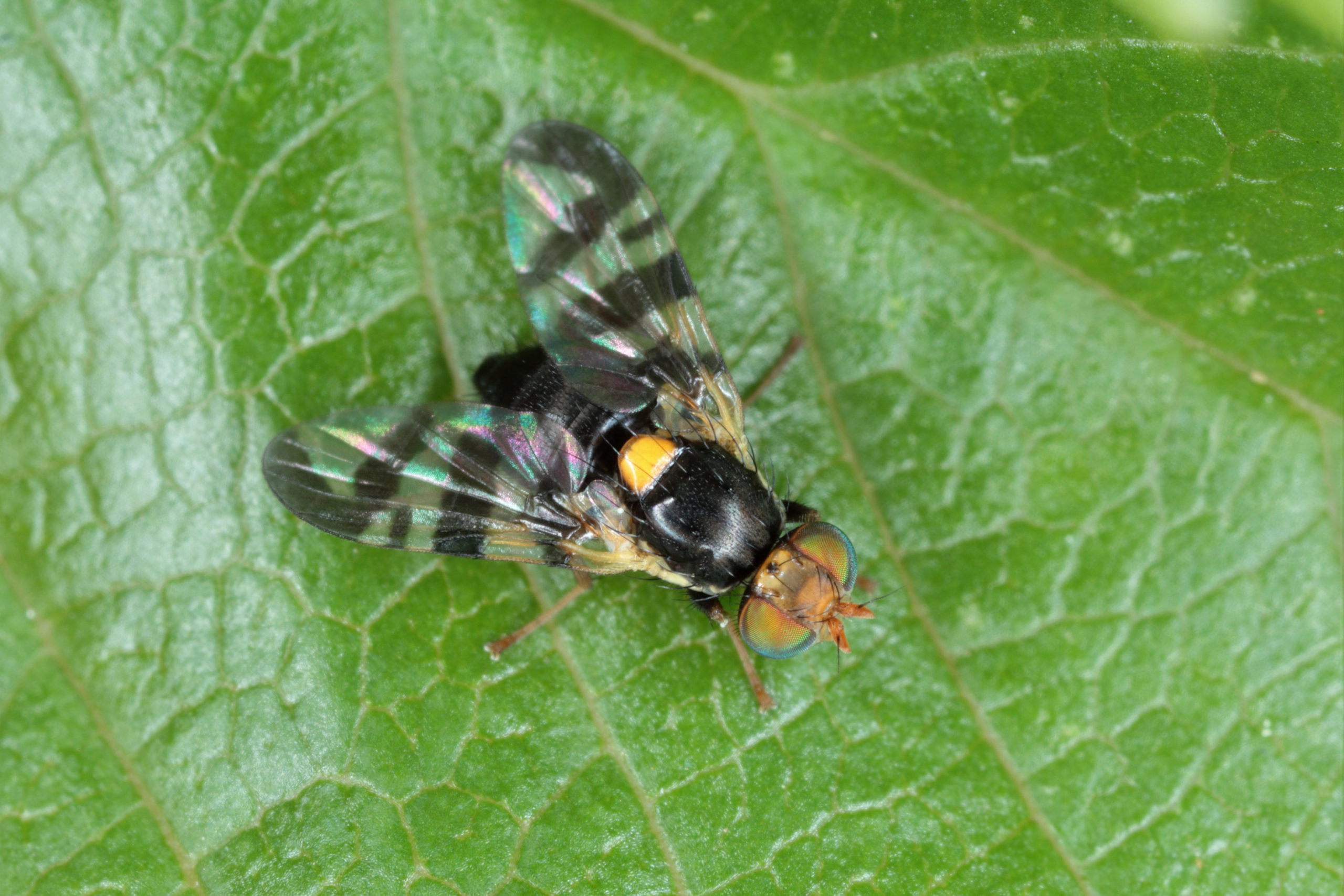
Signs of Infestation: apples are prematurely rotting; misshapen apples; small dimple in side where the egg was laid
We could not think of a more off-putting name for a fruit pest than “apple maggot flies.” The larvae of this species is the main issue with apples, as they can ruin any apple they invade. This is because apple maggot larvae dig into the apples to live and grow, as they have all the food they could dream of within the fruit. The older maggots come from the soil in the summer and eventually fly away to search for food. But they return when it’s time to lay eggs, which they lay under the apple skins. The horrifying part is that there can be hundreds of eggs at a time, which means any apples with those inside are ruined. Apple maggot flies are slightly smaller than common houseflies, so they may be more difficult to see unless you are searching for them. These flies have black spots on their clear wings and a few white stripes on their bodies. They are harmless otherwise, but nothing good can come out of having apple maggot flies in fruit overall.
Codling Moths
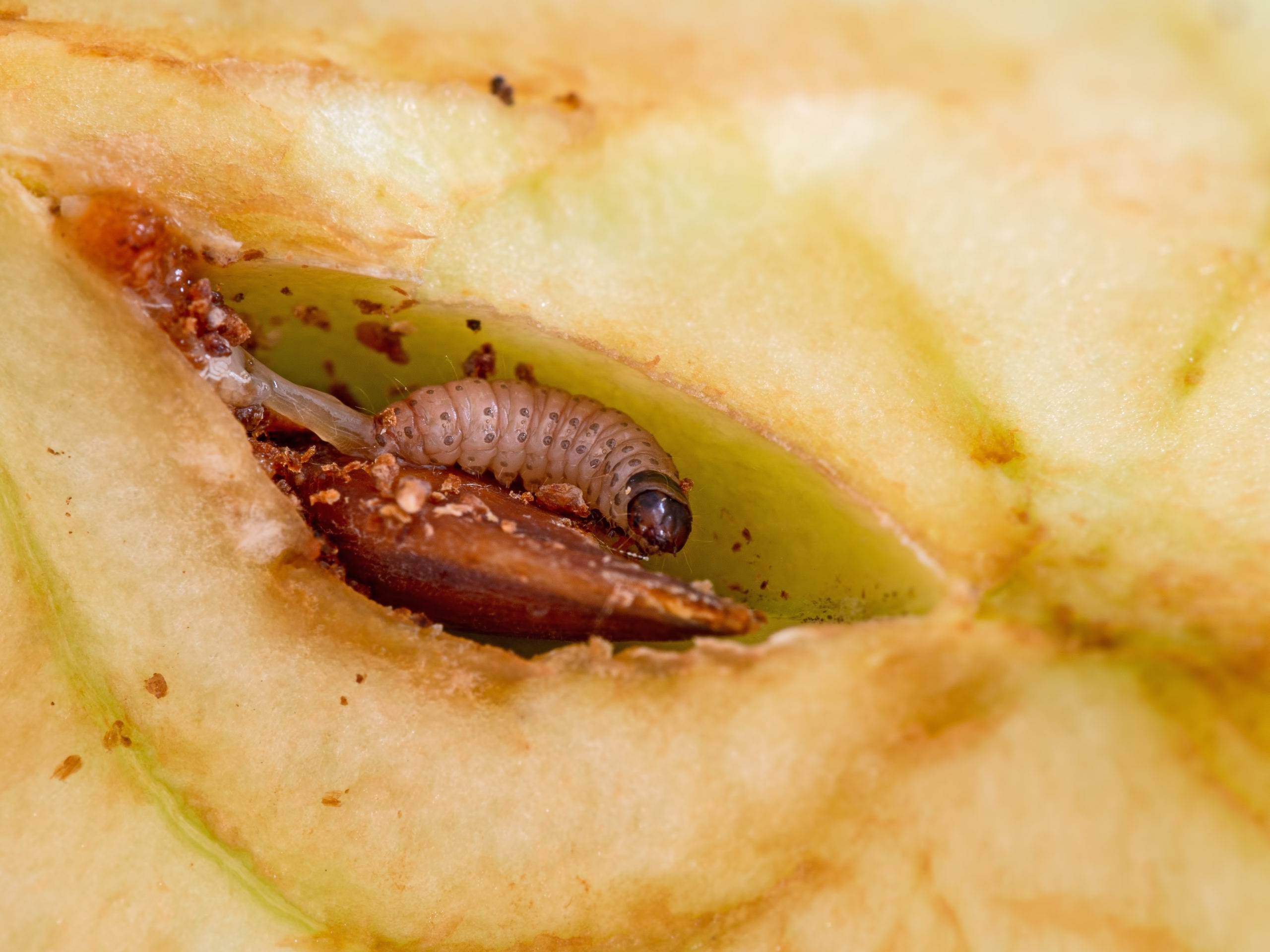
Signs of Infestation: excrement (frass) on exterior of apples; small holes in the apple; apple rot
This is another pest where the larvae ruins the apples by living actually inside the fruit. On that note, here’s a fun fact for you: these larvae are the inspiration behind the infamous worms in apples that are in cartoons and animated movies! The fictional worms definitely look more like earthworms than like these pests, but they act the same. The larvae burrow to the core of the apple where they are the most protected. They grow in there as they eat the fruit, then eventually kill the apple. Codling moths leave the apple trees in the fall to find their overwintering shelter. They then lay eggs in the spring around the fruit so the larvae can enter the fruit when they hatch. The larvae enters the apple near the top, so it is possible to find the entry holes in infested apples. Codling moths may be the most common apple pest out there, which is definitely not a good thing considering how many apples they can destroy with their eggs.
Plum Curculio
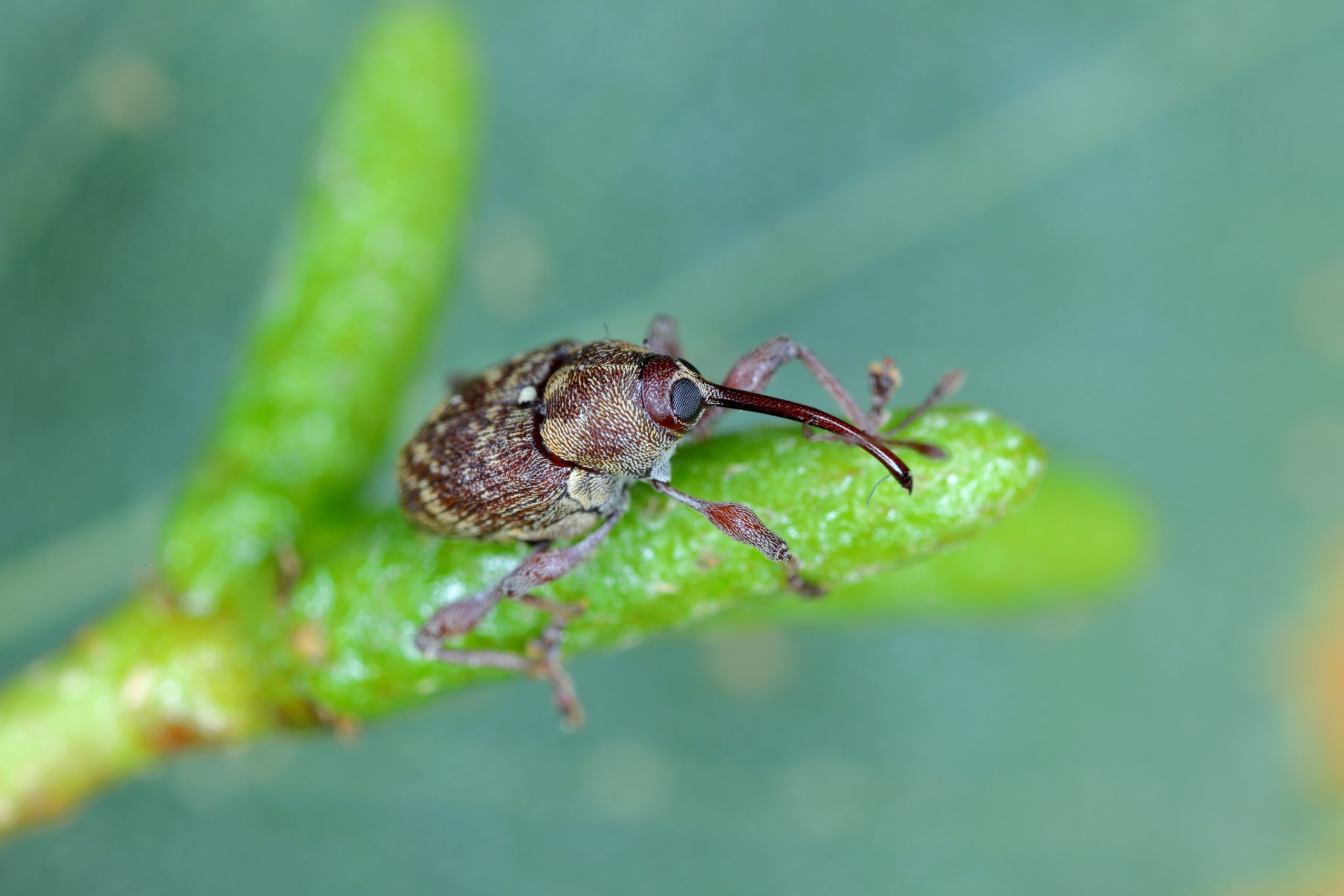
Signs of Infestation: crescent-shaped cuts in apples; misshapen apples; apples falling prematurely
It seems strange that an insect with the word “plum” in its name would be a major apple pest, but here we are. These weevils are famous for the shape they leave behind in the apple after laying eggs. The adult plum curculioes make a small crescent shape in the skin of the apple to lay eggs in, which later hatch and begin eating the apples from the inside. This is what causes the apple to take on a strange shape and texture, then fall from the tree prematurely. The problem with the plum curculio, as with the previous pests, is that they overwinter. Any kind of pest that overwinters is automatically a major problem the next year since they start out ahead with their population. Plum curculioes are a pest of other fruits too, like plums and cherries. The easiest way to treat this kind of pest is to dispose of the fallen and infested fruit immediately, as well as spraying the trees with eco-friendly treatments after they bloom.
Spider Mites
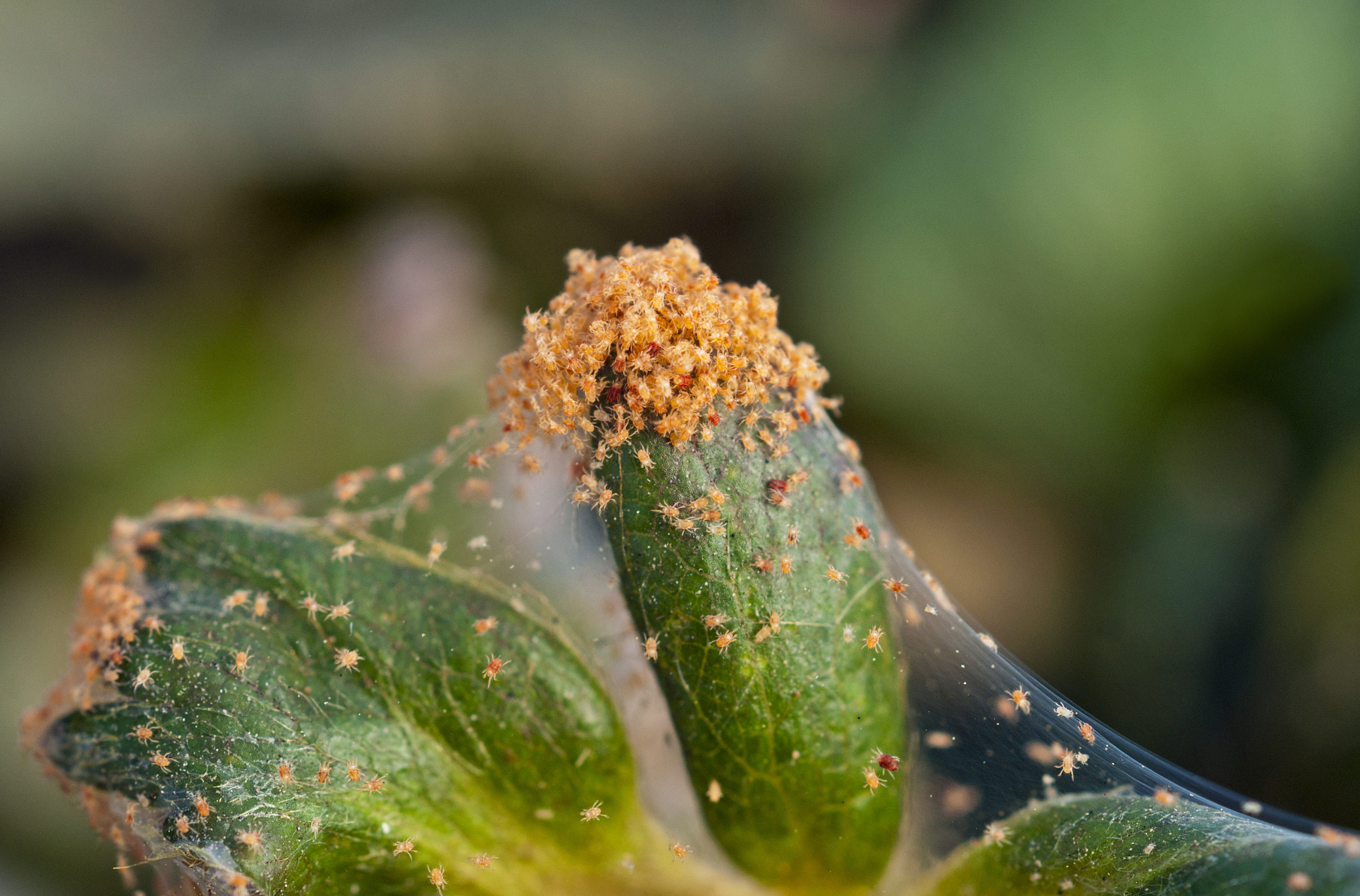
Signs of Infestation: curling leaves; silk webbing around leaves and apples; stippled leaves
Spider mites are a common garden pest in general, so it makes sense that they would also like to invade our fruit trees. These tiny red pests are related to ticks, which is evident when you examine them more closely. Luckily, they are not dangerous to us like ticks are. Spider mites mainly attack the leaves of plants rather than the fruit, and they live on the underside of leaves to prevent being spotted by predators. Spider mites slurp the chlorophyll and sap from leaves, literally draining them of their vital juices. They are even worse in hot weather, as the warmer temperatures cause them to be more active and reproduce quicker. It doesn’t help that they also overwinter, so they start spring off by already attacking the freshly-blooming plants. Make sure that you don’t underestimate these pests due to their tiny size! Spider mites can drain plants so much that they can cause the budding to drastically decrease the next spring, which is another reason to check the leaves of any plants while you do yard work.
Aphids
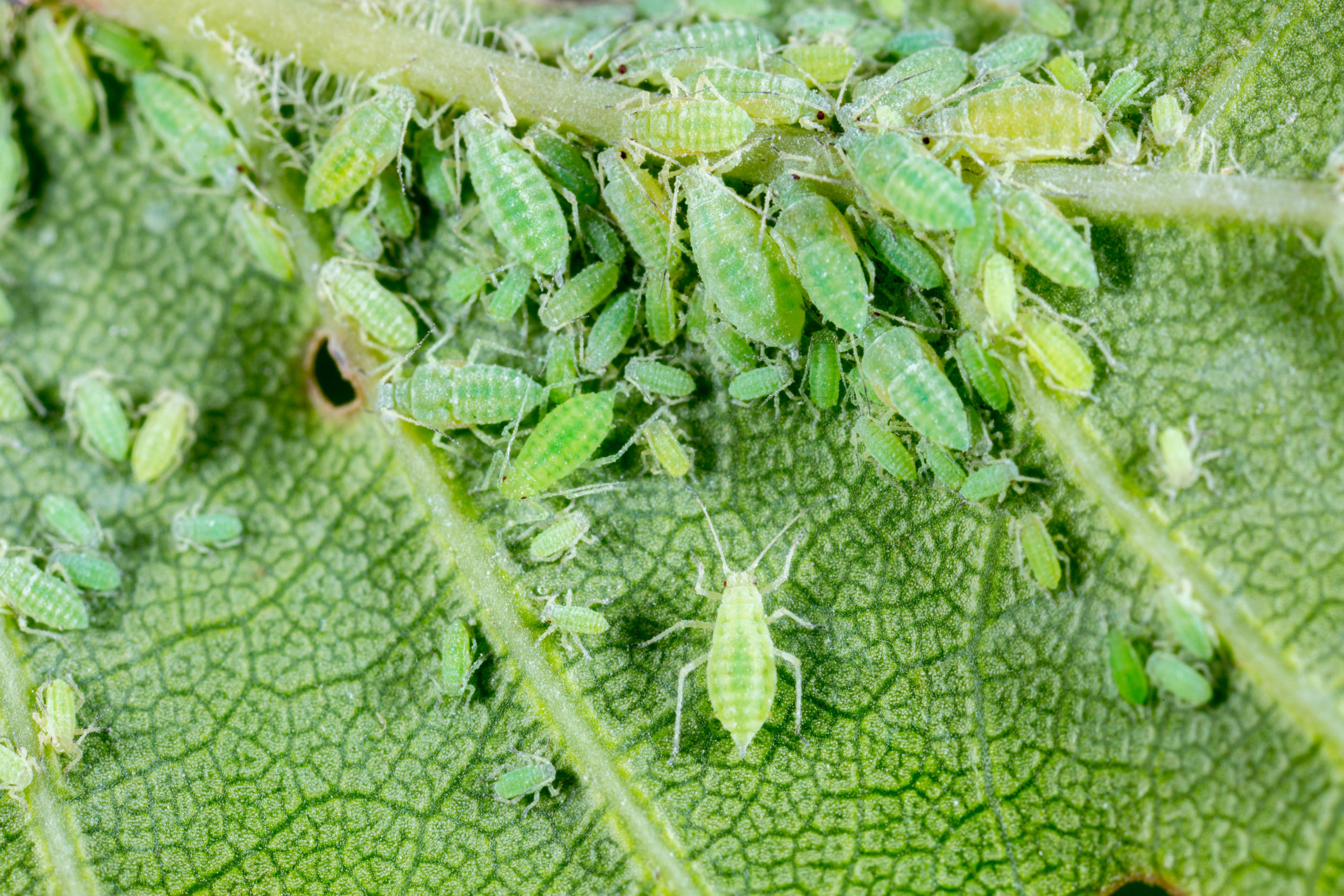
Signs of Infestation: honeydew; possible mold growing on the honeydew; green bugs around the leaves; tiny holes in leaves
Speaking of common frustrating garden pests, aphids can also cause damage to the actual apple trees over time. They attack the leaves by consuming all of the necessary juices and minerals that keep the plants healthy. Aphids seem to prefer younger leaves and stay near the branches. There are multiple generations of aphids born in a year, which is good news for their own species but bad news for our plants. The two most common aphids that attack apple trees are the green apple aphid (appropriately named) and the spirea aphid. These small green insects are difficult to spot in general, which is how they can create a lot of little holes in leaves and gradually drain them before we know it. Luckily, there are plenty of natural predators that control the aphid population every year. Ladybugs are probably the most popular, but lacewings and midges also enjoy the tasty green pests.
Wooly Apple Aphid
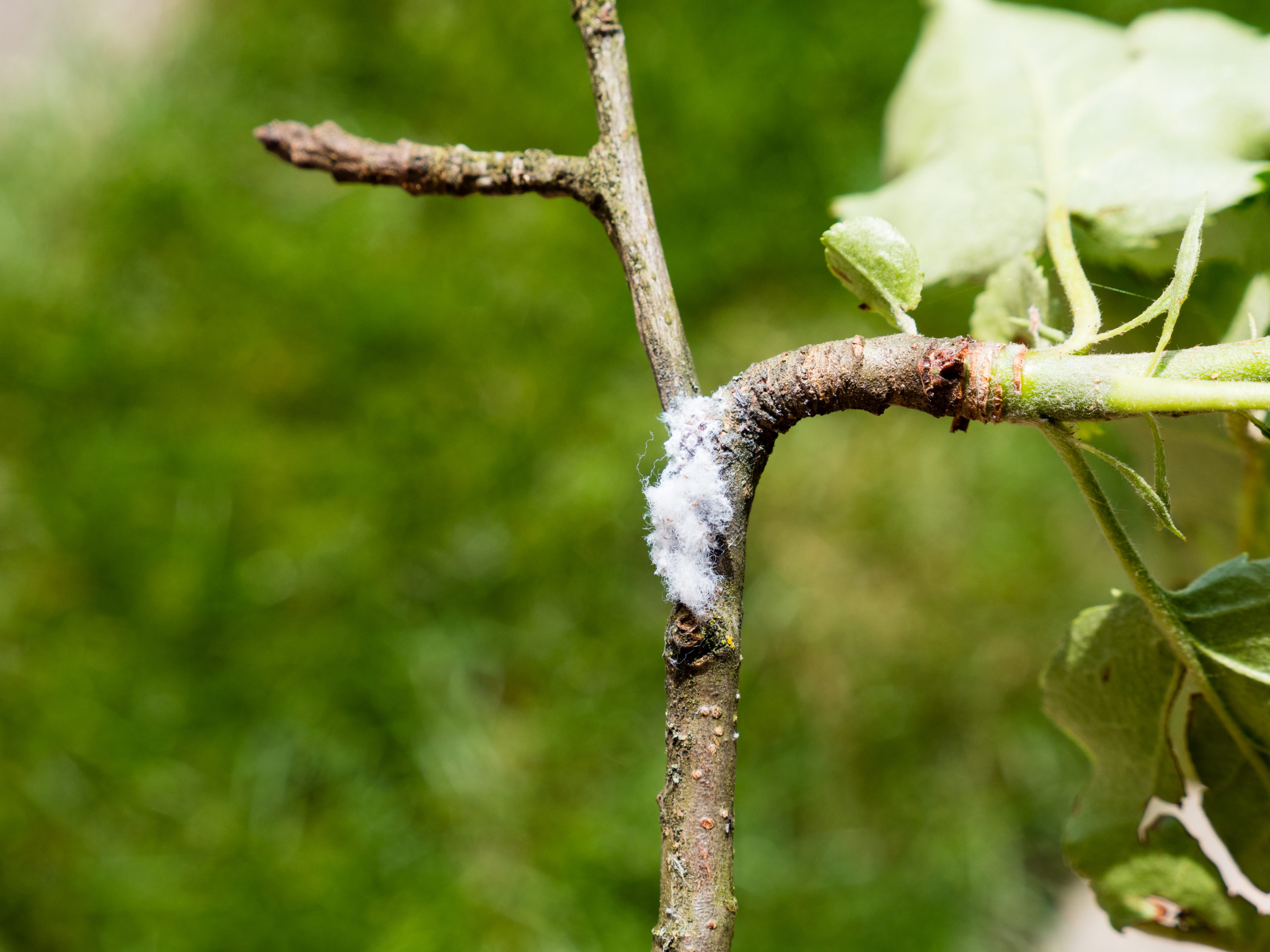
Signs of Infestation: wispy cotton bundles on stems and around fruit; honeydew on leaves; curled leaves; cracked galls on twigs and branches
This is a more specific continuation of the previous one, but the wooly apple aphid is a harmful pest in its own right. They are another extremely common apple pest, hence the name. Wooly apple aphids are known for leaving their wool everywhere they go, which just look like small cotton bundles or jumbled spiderwebs. This is the most clear sign that they have gotten into the apples, an unwelcome sight for any apple grower. These aphids overwinter around the roots of the trees, which means they have a short journey in the spring to reach the leaves and fruit they enjoy. The colonies of the tiny insects are found everywhere on the stems of apples when they invade, usually wrapped in the wool. Cold weather helps keep the wooly apple aphid population down, so a chillier winter is actually a good thing for apples in this regard. As for natural predators, earwigs are a surprisingly great natural pest control for this species in particular. There have even been studies done to show how much earwigs help apples survive attacks from various pests, so finding an earwig on your apple tree may not be the worst thing in the world.
No One Handles the Bad Apples of Pests Like Pest Control Services!
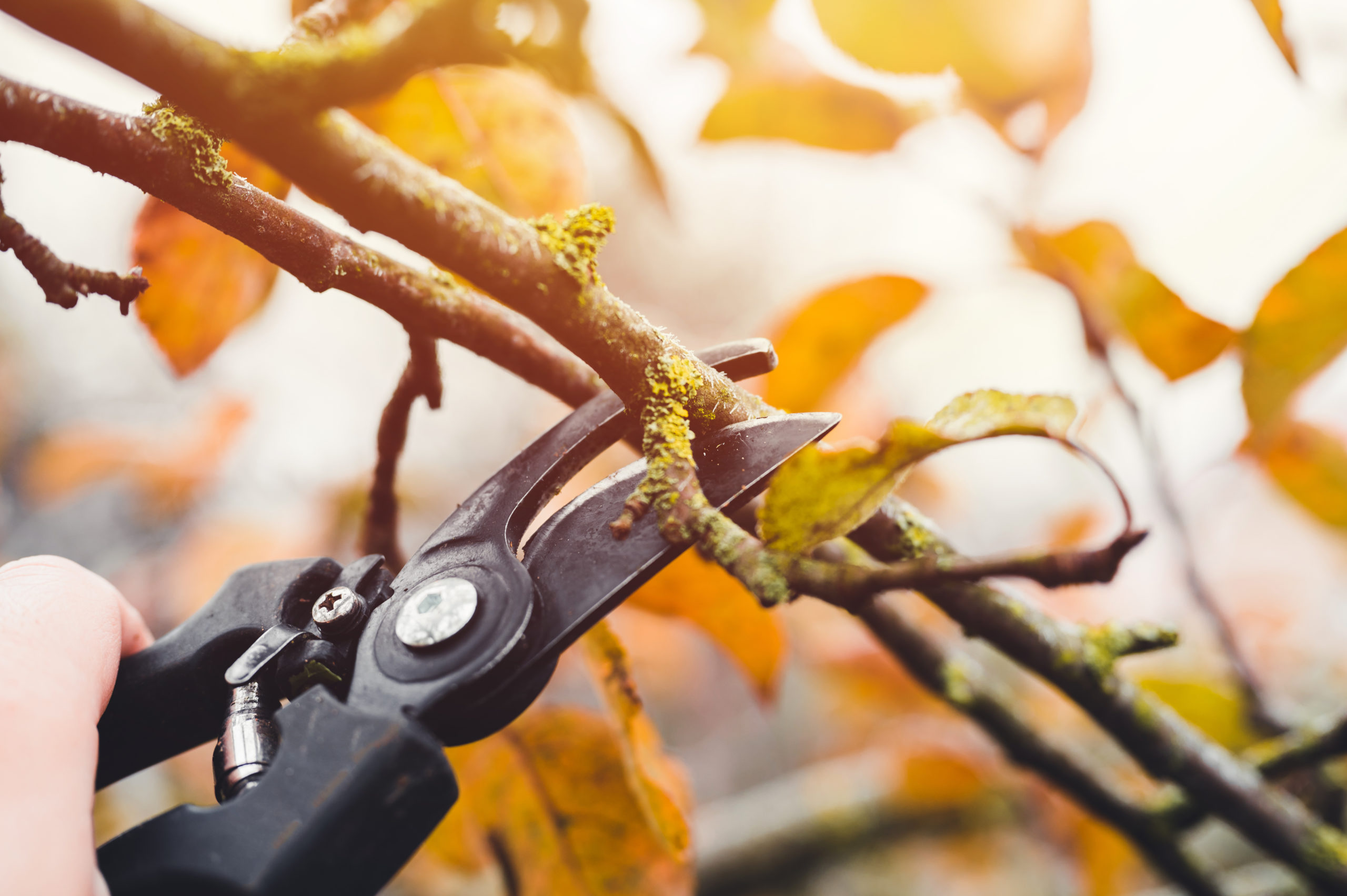
If you have apple trees on your property, there are a few steps you can take to ensure that they produce pest-free apples during the harvest. Keep up the yard work around trees, such as mowing nearby grass and trimming plants. This will ensure that pests who lay eggs or make their nests around trees can’t travel up to infect the apples. Also, keep the trees pruned and kept up throughout the harvest season. Pests thrive in overgrown landscaping, which is how they stay hidden from us for a longer period of time. Remove all fallen apples from the ground soon after they fall so that the fermentation does not attract different pests. Fruit flies and ants love fruit, and they can then move closer to the house if the trees are close enough.
Pest control services is a useful service, no matter what season it currently is. Pest prevention is just as important as pest eradication because it stops the pests from invading the home or yard in the first place. Our eco-friendly treatments stop pests from invading your space without the use of harmful chemicals. This means that you can enjoy a pest-free yard without any dangerous pesticides near your apple trees and other plants! Contact our team for more information on how we can keep your outdoor space pest-free, whether or not apple picking is on the agenda.
Citations
Grant, A. (2021, April 22). Keeping pests out of apple trees: Common insect pests affecting apples. Gardening Know How. Available at https://www.gardeningknowhow.com/edible/fruits/apples/pests-affecting-apples.htm (Accessed on September 23, 2022).
Gorsuch, C.S. (Dr.) & Smith, P. (Dr.). (2021, February 12). Apple & crabapple insects. Clemson Cooperative Extension: Home & Garden Information Center. Available at https://hgic.clemson.edu/factsheet/apple-crabapple-insects/ (Accessed on September 23, 2022).
Hahn, J., Grabowski, M., & MacKenzie, J. (2018). Apple maggots. University of Minnesota Extension. Available at https://extension.umn.edu/yard-and-garden-insects/apple-maggot (Accessed on September 23, 2022).
Murray, M. & Alston, D. (2020, January). Fruit pests: Apple. Utah State University – Utah Pests Extension. Available at https://extension.usu.edu/pests/research/backyard-apple-pests (Accessed on September 23, 2022).
National Gardening Association. (n.d.). Preventing apple pests. HGTV. Available at https://www.hgtv.com/outdoors/flowers-and-plants/fruit/preventing-apple-pests (Accessed on September 23, 2022).
8 Creative Ways to Have a Pest-Free Fourth of July
8 Creative Ways to Have a Pest-Free Fourth of July 8 Creative Ways to Have a Pest-Free Fourth of July Summary: The Fourth [...]
A Simple Guide to Preventing Stinging Pests
A Simple Guide to Preventing Stinging Pests A Simple Guide to Preventing Stinging Pests Summary: Stinging insects are more active in warm weather, [...]
These 10 Natural Mosquito Repellents Can Actually Help
These 10 Natural Mosquito Repellents Can Actually Help These 10 Natural Mosquito Repellents Can Actually Help Summary: Natural mosquito repellents are easier to [...]
How to Get Rid of Carpet Beetles
How to Get Rid of Carpet Beetles How to Get Rid of Carpet Beetles Summary: Carpet beetles are sneaky pests that don’t usually [...]
How Do Roaches Affect Asthma and Allergies?
How Do Roaches Affect Asthma and Allergies? How Do Roaches Affect Asthma and Allergies? Summary: It’s no secret that pests impact human health, [...]
These 5 Carnivorous Pests Might Surprise You!
These 5 Carnivorous Pests Might Surprise You! These 5 Carnivorous Pests Might Surprise You! Summary: There are many eco-friendly ways to prevent pests, [...]

